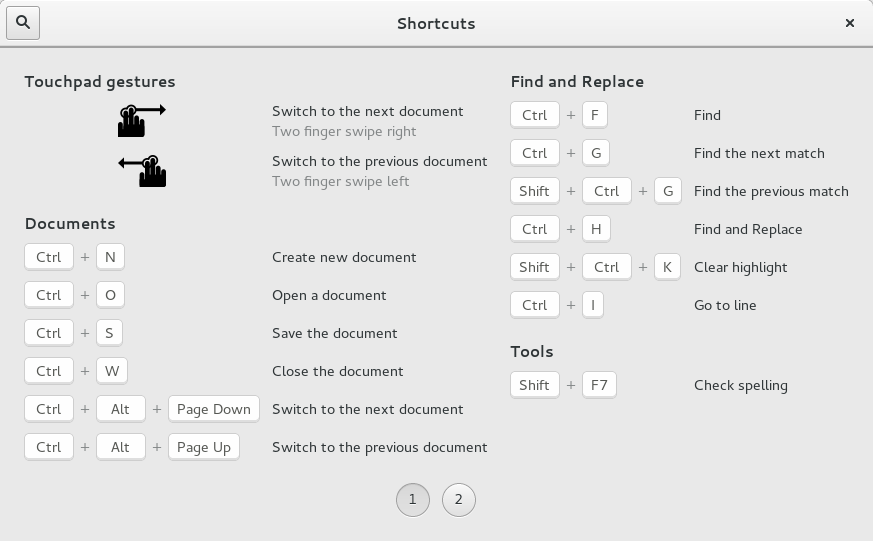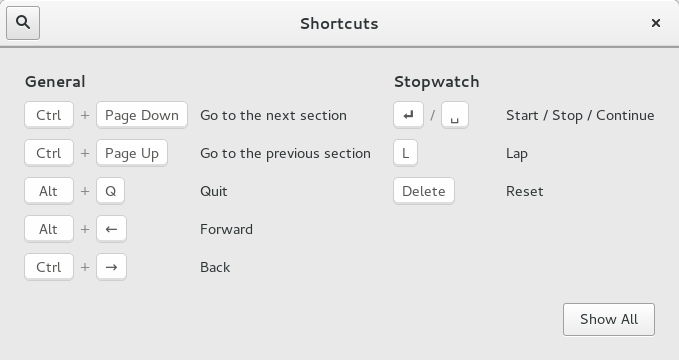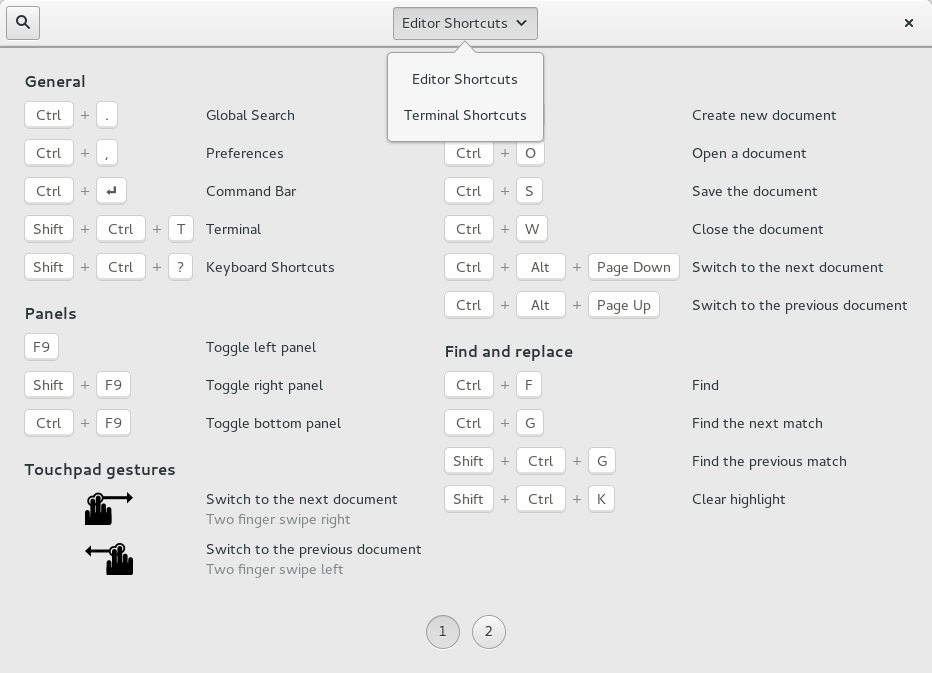Gnome::Gtk3::ShortcutsWindow
Toplevel which shows help for shortcuts

Description
A Gnome::Gtk3::ShortcutsWindow shows brief information about the keyboard shortcuts and gestures of an application. The shortcuts can be grouped, and you can have multiple sections in this window, corresponding to the major modes of your application.
Additionally, the shortcuts can be filtered by the current view, to avoid showing information that is not relevant in the current application context.
The recommended way to construct a GtkShortcutsWindow is with GtkBuilder, by populating a Gnome::Gtk3::ShortcutsWindow with one or more Gnome::Gtk3::ShortcutsSection objects, which contain Gnome::Gtk3::ShortcutsGroups that in turn contain objects of class Gnome::Gtk3::ShortcutsShortcut.
A simple example:

This example has as single section. As you can see, the shortcut groups are arranged in columns, and spread across several pages if there are too many to find on a single page.
The .ui file for this example can be found here.
An example with multiple views:

This example shows a Gnome::Gtk3::ShortcutsWindow that has been configured to show only the shortcuts relevant to the “stopwatch” view.
The .ui file for this example can be found here.
An example with multiple sections:

This example shows a Gnome::Gtk3::ShortcutsWindow with two sections, “Editor Shortcuts” and “Terminal Shortcuts”. The .ui file for this example can be found here.
Synopsis
Declaration
unit class Gnome::Gtk3::ShortcutsWindow;
also is Gnome::Gtk3::Window;
Uml Diagram
Types
Methods
new
:native-object
Create a ShortcutsWindow object using a native object from elsewhere. See also Gnome::N::TopLevelClassSupport.
multi method new ( N-GObject :$native-object! )
:build-id
Create a ShortcutsWindow object using a native object returned from a builder. See also Gnome::GObject::Object.
multi method new ( Str :$build-id! )
Signals
There are two ways to connect to a signal. The first option you have is to use register-signal() from Gnome::GObject::Object. The second option is to use connect-object() directly from Gnome::GObject::Signal.
First method
The positional arguments of the signal handler are all obligatory as well as their types. The named attributes :$widget and user data are optional.
# handler method
method mouse-event ( GdkEvent $event, :$widget ) { ... }
# connect a signal on window object
my Gnome::Gtk3::Window $w .= new( ... );
$w.register-signal( self, 'mouse-event', 'button-press-event');
Second method
my Gnome::Gtk3::Window $w .= new( ... );
my Callable $handler = sub (
N-GObject $native, GdkEvent $event, OpaquePointer $data
) {
...
}
$w.connect-object( 'button-press-event', $handler);
Also here, the types of positional arguments in the signal handler are important. This is because both methods register-signal() and connect-object() are using the signatures of the handler routines to setup the native call interface.
Supported signals
close
The close signal is a keybinding signal which gets emitted when the user uses a keybinding to close the window.
The default binding for this signal is the Escape key.
method handler (
Int :$_handle_id,
Gnome::GObject::Object :_widget($shortcutswindow),
N-GObject :$_native-object,
*%user-options
);
-
$_handler-id; The handler id which is returned from the registration
-
$_widget; The instance which registered the signal
-
$_native-object; The native object provided by the caller wrapped in the Raku object.
search
The search signal is a keybinding signal which gets emitted when the user uses a keybinding to start a search.
The default binding for this signal is Control-F.
method handler (
Int :$_handle_id,
Gnome::GObject::Object :_widget($shortcutswindow),
N-GObject :$_native-object,
*%user-options
);
-
$_handler-id; The handler id which is returned from the registration
-
$_widget; The instance which registered the signal
-
$_native-object; The native object provided by the caller wrapped in the Raku object.
Properties
An example of using a string type property of a Gnome::Gtk3::Label object. This is just showing how to set/read a property, not that it is the best way to do it. This is because a) The class initialization often provides some options to set some of the properties and b) the classes provide many methods to modify just those properties. In the case below one can use new(:label(‘my text label’)) or .set-text(‘my text label’).
my Gnome::Gtk3::Label $label .= new;
my Gnome::GObject::Value $gv .= new(:init(G_TYPE_STRING));
$label.get-property( 'label', $gv);
$gv.set-string('my text label');
Supported properties
Section Name: section-name
The name of the section to show.
This should be the section-name of one of the Gnome::Gtk3::ShortcutsSection objects that are in this shortcuts window.
The Gnome::GObject::Value type of property section-name is G_TYPE_STRING.
View Name: view-name
The view name by which to filter the contents.
This should correspond to the view property of some of the Gnome::Gtk3::ShortcutsGroup objects that are inside this shortcuts window. Set this to undefined to show all groups.
The Gnome::GObject::Value type of property view-name is G_TYPE_STRING.